Joint Public Statement on Root Canal Treatment
from the
Canadian Dental Association and
Canadian Academy of Endodontics
Root canal treatment, also referred to as endodontic therapy, is an effective and safe treatment for teeth whose pulp has become inflamed or infected. It can also be required in other situations to help save and restore a tooth.
Root canal treatment is routinely performed successfully by dentists across Canada. A dentist who has taken advanced training in endodontic therapy is called an endodontist and may be recommended by your dentist for more complex cases. Root canal treatment remains, for many patients, the only viable option to retain a tooth that has suffered severe damage or has become infected.
Root canal treatment is the process of removing infected or injured tissue (pulp) from inside the crown and roots of a tooth. Once cleaned, the canal is disinfected, shaped, filled and sealed with natural rubber-like material called gutta percha. The opening of the tooth is then sealed with either a temporary or permanent filling to prevent future infection. Considerable advancements in diagnosis, radiographic imaging, equipment and techniques now permit dentists and endodontists to complete root canal treatment, even for teeth with very complex anatomies, to the highest level of precision.
The Canadian Dental Association (CDA) and the Canadian Academy of Endodontics (CAE) caution that misinformation about root canal treatment is circulating in the public domain. Patients are advised to discuss any questions or concerns about root canal treatment with their dentist and endodontist to ensure that unnecessary anxiety or fear of developing other health problems does not result in treatment delays which could further compromise the integrity of the tooth.
Taking proper care of your teeth and gums is a lifelong commitment. The best way to prevent the need for root canal treatment is to follow a good oral hygiene routine by brushing twice a day, flossing once a day, and to visit your dentist regularly.
Please visit these trustworthy sources of information which address common misconceptions about root canal treatment.
- The Canadian Academy of Endodontics: Safety of endodontic treatment
- The Canadian Cancer Society: Do Root Canals Cause Cancer?
The Canadian Dental Association (CDA) and the Canadian Academy of Endodontics (CAE) are aware that misinformation about root canal treatment is circulating in the public domain. False claims about root canal treatment is harmful because it creates undue fear, or confusion among patients and their families which can lead to delays in seeking treatment and result in the loss of otherwise treatable teeth. The spread of inaccurate information about root canal treatment is not beneficial to patients in terms of their comfort, safety, or long-term health.
Since patient safety, quality oral health care, and knowledge about oral health and related procedures are top priorities for CDA, it has worked with the CAE to provide the most current and factual information about root canal treatment and its safety. The CDA is committed to share important information about oral health and will continue to monitor the situation.
Root Canal Treatment
When the nerve of your tooth becomes infected, a successful root canal treatment lets you keep the tooth rather than having to pull it out. Keeping your tooth helps to prevent your other teeth from drifting out of line and causing jaw problems. Saving a natural tooth avoids having to replace it with an artificial tooth.
What is root canal treatment?
Who does this procedure?
How is a root canal treatment done?
How is a tooth restored after root canal treatment?
What else should I know?
What is root canal retreatment?
What is root canal surgery?
What is root canal treatment?
Root canal treatment, also known as endodontic treatment, is the process of removing infected, injured or dead pulp from your tooth. The space inside the hard layers of each tooth is called the root canal system. This system is filled with soft dental pulp made up of nerves and blood vessels that help your tooth grow and develop.
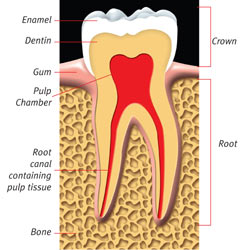
|
|
A healthy tooth. |
When bacteria (germs) enter your tooth through deep cavities, cracks or flawed fillings, your tooth can become abscessed. An abscessed tooth is a tooth with an infection in the pulp. If pulp becomes infected, it needs to be removed. An abscessed tooth may cause pain and/or swelling. Your dentist may notice the infection from a dental x-ray or from other changes with the tooth. If left untreated, an abscessed tooth can cause serious oral health problems.
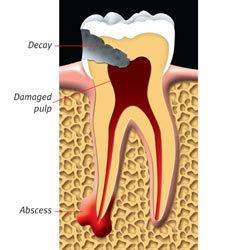
|
|
An abscessed tooth. |
Who does this procedure?
Your dentist may do root canal treatment or refer you to an endodontist. An endodontist is a dentist who has completed a university post-graduate specialty program in endodontics. Endodontics is a specialty of dentistry concerned with the treatment of the dental pulp or nerve of the tooth.
If your child's primary (baby) tooth is damaged, your dentist may refer you to a pediatric dentist for this procedure. A pediatric dentist has at least 2 years of extra university training in treating children.
How is a root canal treatment done?
- The dentist gives you a local anesthetic (freezing).
- To protect your tooth from bacteria in your saliva during the treatment, the dentist places a rubber dam around the tooth being treated.
- The dentist makes an opening in the tooth to reach the root canal system and the damaged pulp.
- Using very fine dental instruments, the dentist removes the pulp by cleaning and enlarging the root canal system.
- After the canal has been cleaned, the dentist fills and seals the canal.
- The opening of the tooth is then sealed with either a temporary or permanent filling.
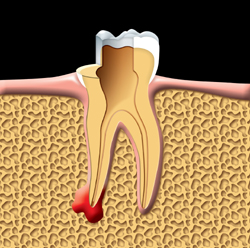
|
|
The damaged pulp is removed. |
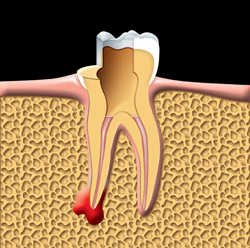
|
|
The root canals are filled and sealed. |
How is a tooth restored after root canal treatment
After a root canal treatment, your tooth has to be restored (fixed) to look, feel and work as much like a natural tooth as possible. If an endodontist performed your root canal treatment, he or she will fill the opening of the tooth with a temporary filling and send you back to your dentist or prosthodontist for tooth restoration.
A prosthodontist is a dental specialist who restores and replaces teeth using crowns, bridges, dentures and implants. Your dentist or specialist may use a permanent filling or a crown to restore your tooth. The choice of restoration will depend on the strength of the part of the tooth that's left. A back tooth will likely need a crown because chewing puts a great deal of force on back teeth. If there is not enough of the tooth left, posts may be used to help support the crown.
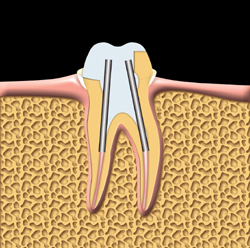
|
|
The tooth is prepared for a crown. |
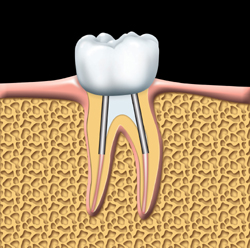
|
|
The crown is cemented into place. |
What else should I know?
Root canal treatment may be done in 1 or 2 appointments. After root canal treatment, your tooth may be tender for the first week or two. Bad pain or swelling are NOT common. If this happens, call your dentist or endodontist.
You can still get a cavity or gum disease after a root canal treatment. Root canal treatment does not protect your tooth from other types of damage. With proper care and regular dental visits, the tooth could last as long as your other teeth. Most of the time, a tooth that has had a root canal treatment can be saved. However, there are cases where everything possible has been done to save a tooth and still the tooth must be extracted (pulled).
What is root canal retreatment
Most root canal treatments are successful. But in some rare cases, a second root canal treatment is needed. This is called retreatment. When retreating a tooth, the root canal filling material is taken out, and the canal is recleaned, reshaped and refilled.
What is root canal surgery
Sometimes root canal surgery is needed when a regular root canal treatment cannot be done or when it has not worked. Surgery is done to:
- Check the end of the root for fractures (cracks).
- Remove parts of the root that could not be cleaned during regular root canal treatment.
- Clear up an infection that did not heal after regular treatment.













